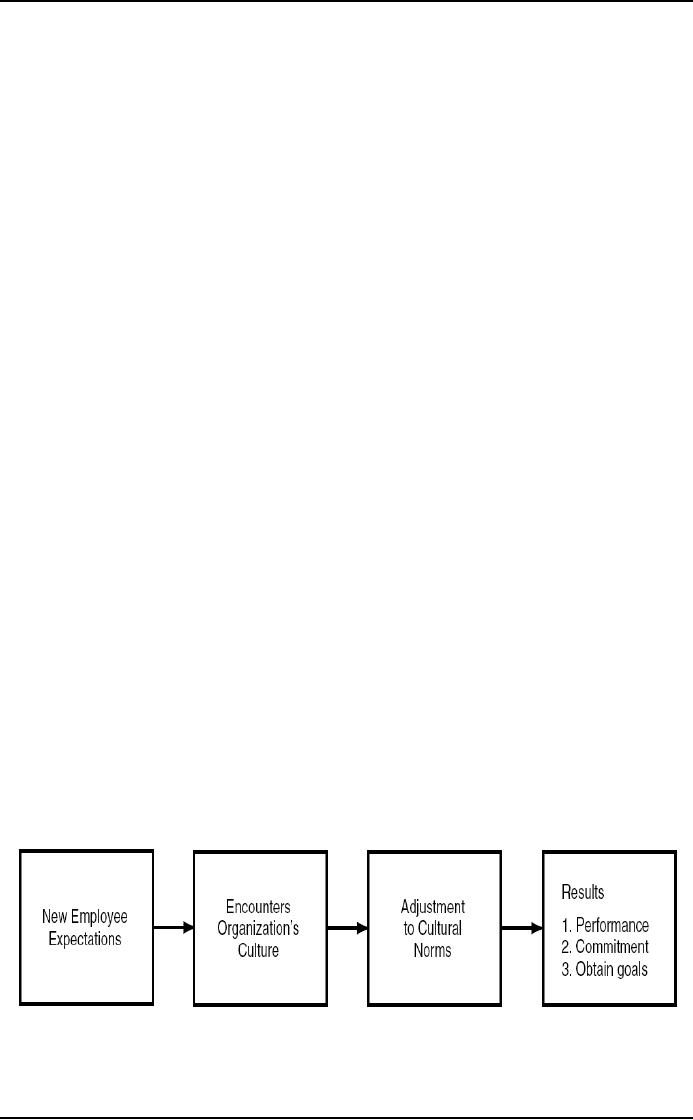 |

Organization
Development MGMT
628
VU
Lesson
06
The
Organization Culture
Basically,
organizational culture is the personality of the organization. Culture is
comprised of the
assumptions,
values, norms and tangible
signs (artifacts) of organization members
and their behaviors.
Culture
is one of those terms that
are difficult to express
distinctly, but everyone
knows it when they sense
it.
For example, the culture of a large,
for-profit corporation is quite
different than that of a hospital
which
is
quite different that that of
a university. You can tell
the culture of an organization by looking at
the
arrangement
of furniture, what they brag about, what
members wear, etc. --
similar to what you can use
to
get
a feeling about someone's personality.
Definition:
"The
culture of an organization is its customary
and traditional way of
thinking and doing things,
which is
shared
to a greater or lesser degree by
all its members, and
which new members must
learn and at least
partially
accept, in order to be accepted
into service in the firm. Culture
covers a wide range of behavior:
the
methods of production; job
skills and technical knowledge;
attitudes towards discipline
and
punishment;
the custom and habit of
managerial behavior; its way of
doing business; the methods
of
payment;
the values placed on different
types of work; beliefs in
democratic living and joint
consultation".
Culture
shows up in both visible and
invisible ways. Some
manifestations of this energy field
called
"culture"
are easy to observe. You
can see the dress code,
work environment, perks, and
titles in a
company.
This is the surface layer of culture.
These are only some of the
visible manifestations of a culture.
The
far more powerful aspects of
culture are invisible. The cultural
core is composed of the beliefs,
values,
standards,
paradigms, worldviews, moods, internal
conversations, and private
conversations of the people
that
are part of the group. This is the
foundation for all actions
and decisions within a team,
department, or
organization.
Visible
Manifestations of Culture:
�
Dress
Code
�
Work
Environment
�
Benefits
�
Perks
�
Conversations
�
Work/Life
Balance
�
Titles
& Job Description
�
Organizational
Structure
Invisible
Manifestations of Culture:
�
Values
�
Private
Conversations (with self or
confidants)
�
Invisible
Rules
�
Attitudes
�
Beliefs
�
Worldviews
�
Moods
and Emotions
�
Unconscious
Interpretations
�
Standards
of Behavior
�
Paradigms
�
Assumptions
Business
leaders often assume that
their company's vision,
values, and strategic
priorities are
synonymous
with
their company's culture. Unfortunately,
too often, the vision,
values, and strategic
priorities may only
be
words hanging on a plaque on the wall. In a
thriving profitable company,
employees will embody the
values,
vision, and strategic
priorities of their company.
What creates this embodiment (or
lack of
embodiment)
is the culture that permeates the
employees' psyches, bodies,
conversations, and
actions.
The
energy fields that make up a
group's culture are dynamic
and change continuously.
Culture is created
and
constantly reinforced on a daily basis
through conversations, symbols, rituals,
written materials,
and
body
language. It is the small, mundane
actions and behaviors that
create a culture and can
shift a culture.
Creating
and sustaining a healthy, vibrant culture
requires reinforcement of the culture through daily
and
proactive
conversations and communications.
The failure to discuss the
values, purpose, and rules
within a
group
often leads to a culture that is at
cross purposes with the
stated intention of the group.
Poor
communication
creates a lot of confusion and
often a crisis of
meaninglessness.

Organization
Development MGMT
628
VU
Since
a culture is created every time a group
of people come together to form a team, a
company will have
many
sub-cultures that exist
within its main culture.
Within the company, there
may be sub-cultures in
departments,
divisions, regions or operating units. For
example, the marketing and technology
teams may
have
different worldviews, jargon, work hours,
and ways to do things. A big
challenge for today's
company
is
to create a strong, cohesive corporate
culture that pulls all of the
sub-cultures together and ensures
that
they
can work as a unified
team.
Corporate
culture starts when the organization begins
and develops as it grows. Corporate
culture controls
the
way the people in an organization interact with
each other and the
stakeholders outside the
organization.
Over time, the culture changes as people
come and go. Culture
reflects the values,
ethics,
beliefs,
personality and traits of the company's founders,
management and employees. In a
well-established
company,
the culture is so strong that even new
top management may not be
able to change it. Or, if
they
try,
it may take 5, 10 or 20 years to
change. Employees who feel comfortable
and compatible with
the
company
culture will stay; those who
don't will leave or will
not perform as well as they
can.
Culture
is extremely powerful. The
rules of the game, what behavior is
ethical and accepted, the
mood of
the
organization, and the enthusiasm of
employees are all contained in the
culture. So, culture can be a
powerful,
hidden asset or it can be a
liability - a time-bomb waiting to go
off. If your leadership team
has
not
pro-actively created a corporate culture to support
the company's purpose, then
chances are that the
culture
is a hidden liability.
Every
time people come together with a shared
purpose, culture is created. This
group of people could be a
family,
neighborhood, project team, or
company. Culture is automatically created
out of the combined
thoughts,
energies, and attitudes of the people in the
group.
Have
you ever noticed how people
react to foreign visitors; whether an
exchange student or a
visiting
professional?
The stranger may be
welcomed, but may never be
accepted unless that person
can adapt to
the
norms of their new
environment. If they do not, the members
will shun the stranger and
reject the alien
from
their culture. The same is true in
business. If the new employee, consultant
or visitor cannot adapt to
the
corporate culture, their chances for
success are slight. The
members of the culture will reject the
person
outright
and will work against
them.
The
reason for this phenomenon is because
people tend to prefer conformity in their
culture. Conformity
represents
a harmonious environment where the
behavior and actions are
predictable. Most people have a
deeply
rooted desire for a sense of
order and stability in their
lives, which is what conformity provides.
A
stable
environment promotes self-confidence in
the members of the culture and allows
them to concentrate
on
their work.
Culture
is an energy force that becomes
woven through the thinking,
behavior, and identity of
those within
the
group. Culture is powerful and
invisible and its
manifestations are far
reaching. Culture determines
a
company's
dress code, work
environment, work hours,
rules for getting ahead and
getting promoted, how
the
business world is viewed, what is
valued, who is valued, and
much more.
The
term organization culture refers to a system of
shared meanings, including the
language, dress,
patterns
of
behavior, value system,
feelings, attitudes, interactions, and
group norms of the members. Examine
the
patterns
of behavior on your campus or in
your company. How do people
dress? What jargon or unique
terms
do they use?
Norms:
Norms
are organized and shared
ideas regarding what members should do
and feel, how this
behavior
should
be regulated, and what sanctions should
be applied when behavior does not
coincide with social
expectations.
The values and behaviors of
every organization are unique. Some
patterns of behavior may
be
functional
and may facilitate the accomplishment of
organizational goals. Other patterns of
behavior or
cultural
norms may actually inhibit
or restrict the accomplishment of organization
goals.
A
look at the types of norms
that exist in an organization will
help in gaining a better understanding of the
organization's
culture. Norms are generally enforced
only for the behaviors
viewed as most important
by
most
group members. Norms
essential to accomplishing the
organization's objectives are
called pivotal
norms.
Norms that support and
contribute to the pivotal norms
but are not essential to the
organization's
objectives
are called peripheral
norms. For
example, dress codes that
are enforced Monday
through
Thursday
are probably peripheral in light of
Friday's being a casual dress
day. Pivotal and peripheral
norms
constantly
confront individuals in an organization,
and they must decide whether or
not to conform. The
pressure
to conform to norms varies,
allowing individuals some
degree of freedom in responding to
these
organizational
pressures depending on how they perceive
the rewards or punishments. The
organization
also
has latitude in the degree of
conformity it requires of its
members.

Organization
Development MGMT
628
VU
The
Socialization Process:
Even
if an organization does an effective job of
recruiting, new employees must
still adjust to the
organizational
culture. Because they are not
aware of the culture, new employees
are likely to disagree
with
or
question the customs and values
that exist. Socialization
may be defined as the process
that adapts
employees
to the organization's culture. The
socialization of employees at Procter
and Gamble Co. starts
at
an
early age because employees
often begin their careers
there and grow up together.
The culture is one of
being
resistant to new ideas and
even being insular. P&G is, by many
measures, a family company
and only
promotes
from within. It is located in a
relatively small city, Cincinnati,
where employees live near
one
another,
go to the same social functions, and
eat at the same restaurants.
CEO Alan Lafley admits, "I
am
worried
that I will ask the organization to
change ahead of its
understanding, capability, and
commitment."
New
Employee Expectations:
To
function effectively, managers
and members must be aware of
the organization's norms. They
must
recognize
how sharply norms are
defined and how strongly they
are enforced. Entry into a
new situation
often
results in some degree of anxiety or
stress. The less an
individual can relate the
new situation to
previous
situations, the greater the feelings of
anxiety and discomfort. The more the
individual can meet
expectations,
the less the feelings of anxiety and
discomfort.
Some
organizations assign current employees to
act as mentors to new
employees. W. L. Gore &
Associates
assigns each person hired by
the company a sponsor who
acts as a mentor. Twenty
percent of
Gore's
associates (employees) are
sponsors, and the sponsor is
typically the person who has
the most at
stake
in making the new associate successful.
The Gore philosophy is that
if you sponsor someone,
you
want
them to be successful, and therefore will
offer them opportunities, such as
sitting in on meetings. If
the
new associate is successful, the
team will be successful, and
Gore will be
successful.
Encounter
Organization's Culture:
The
organizational culture provides a way for organization
members to meet and get
along. Three
important
aspects of socialization when joining an
organization are:
1.
Deciding who is a member and
who is not.
2.
Developing an informal understanding of
behavioral norms
3.
Separating friends from
enemies.
To
work together effectively, individuals
need to understand things like
power, status, rewards,
and
sanctions
for specific types of
behaviors. For instance, what
behavior gets one a good
grade, and so on.
While
the individual employees are
experiencing a new situation, the organization
may be attempting to
influence
them. If new members come to
an organization expecting to find a
certain set of norms, they
are
looking
for their expectations to be
affirmed. If their expectations reflect
the actual norms of the
organization,
the integration process for
both the new members and the
organization is relatively painless.
Adjustment
to Cultural Norms:
New
members often find that the
norms are unclear, confusing,
and restrictive. As a result, they may
react
in
different ways when entering an organization. At
one extreme, a new member
may choose to conform
to
all
the norms of the organization, resulting in uniformity
of behavior and complete
acceptance of
organizational
values. This conformity may
result in stagnation, non-responsiveness,
and a loss of
creativeness.
At the other extreme, a new
member may choose to rebel,
to reject all the values, or to
leave
the
organization altogether.
Figure:
06
A
less obvious alternative is for
new members to accept the
pivotal norms and seriously
question the
peripheral
norms, which can be termed
creative individualism. This is the
ideal behavior for a healthy
and
effective
organization, but it is often difficult
for a newcomer to correctly determine
which norms are
peripheral
and which are pivotal. What
may be a pivotal norm in one
department may be a peripheral
norm

Organization
Development MGMT
628
VU
or
not a norm at all in another department
of the same organization. Since norms
are changing and
dy-
namic,
the organization member must have the
awareness to discern the differences
between pivotal and
peripheral
norms.
Results:
Only
the more healthy organizations allow
their members to challenge
their norms. The aim of OD
is to
develop
an organizational climate that is appropriate to the
organization's mission and
members. In a sense,
OD
involves changing the culture of organizations
and work groups so that a
more effective means of
interacting,
relating, and problem solving will
result. OD seeks to develop the organization to the
point that
it
feels comfortable about allowing its
members to openly examine the
norms, both pivotal and
peripheral,
with
the ultimate goal of building a more
effective organization. The reaction of the individual
to the norms
results
in the formation of an unwritten
agreement with the organization.
For
example, at one organization employees
believe that it is their responsibility
to innovate and be
creative.
They develop new and improved
products, processes, and
ways to serve their
customers. They
believe
that team discussion,
challenging ideas, and
taking risks are appropriate
behaviors for
achieving
goals.
However, at another organization employee
believe that following
procedures, reaching
numerical
outcome
targets, doing no more or
less than what is required, and
not saying anything that the
boss does
not
want to hear are the appropriate
behaviors. These two
organizations have very different
types of
cultures.
In both of these organizations,
each person tends to do the
following:
1.
Separate
more important from less
important goals.
2.
Develop
ways to measure their
accomplishments.
3.
Create
explanations for why goals
may not always be
met.
Psychological
Contracts:
A
psychological contract may be defined as
an unwritten agreement between
individuals and the
organization
of which they are members. It
describes certain expectations
that the organization has of the
individual
and the individual's expectations of the
organization. Because the two parties
are growing and
changing,
the contract must be open-ended, so that
old issues and new
issues can be
renegotiated.
An
organization has certain expectations of
its members. If it is a business
organization, its expectations of
member
behavior will probably be
spelled out very clearly. It
undoubtedly expects its
members to be on the
job
during certain hours of the
day. It is probably concerned
with the quality and
quantity of the work they
do,
their loyalty, their
appearance, and various
other things unique to the organization. For the
organization
to
be satisfied, the individual will
need to comply to some degree
with its expectations. In
other words, the
organization
has certain requirements,
and the individual must do
certain things to meet those
requirements
if
there is to be a lasting and healthy
relationship. In many instances,
unfulfilled expectations result in
high
turnover,
absenteeism, sabotage, and
worker alienation.
Similarly,
the individual has certain
expectations of the organization. An individual
may expect to gain
work
experience,
security, and advancement.
The individual probably
expects to have an opportunity to
meet
people,
make friends, and form
social relationships; and
undoubtedly expects remuneration from
the
organization.
For the individual to be satisfied
and stay, the organization will
have to meet the
individual's
expectations.
When
either the organization's or the individual's
expectations are not being
satisfied adequately by the
other
party, friction and
difficulties may develop. If these
problems cannot be solved, they may
culminate
in
the individual's leaving the organization, either
voluntarily or by the organization's
choice. All too
often,
the
problem is solved by not solving
it: it takes too much
effort to reach a real
solution, so both
parties
must
continue with a tenuous and unharmonious
relationship.
Sometimes
the psychological contract between the organization
and the individual does not
even address
certain
key expectations. One or both
parties may assume that the
other party agrees to some
unstated
expectations.
The phrase "it is
intuitively obvious to the most
casual observer" may be the
underlying
assumption
of one or both parties. Unstated or
assumed expectations can
lead to an organization of
individuals
who feel cheated or of managers
who are disappointed in their
subordinates. To avoid
such
misunderstandings,
both parties the members and
the representatives of the organization should
formulate
a
psychological contract that can be
continually renegotiated.
OD
in Practice: What's your culture
worth?
The
founders of Setpoint had a pretty good
idea of the sort of company culture they
wanted to build. It
didn't
occur to them that what they came up
with would become one of the
company's most
valuable
assets.
Steve
Peterson, owner of his own
company, Peterson Inc., with
about 300 employees, says he
had no
particular
agenda when he dropped by Setpoint for a
visit. He certainly wasn't thinking about
a merger.

Organization
Development MGMT
628
VU
Setpoint
was just another custom-manufacturing
company employing only about 30
employees. Most of
its
revenues
come from designing and
building factory-automation equipment. He'd
heard about some of
the
things
they were doing with project
management and open-book
accounting. Setpoint CEO, Joe
Knight,
took
Peterson on a tour of the facility. At
some point they wound up in the
shop, where about 10
employees
were working on half a dozen
machines. Peterson noticed a large
whiteboard off to one
side.
Scribbled
across the board were about 20
rows and 10n columns of
numbers forming a table of
some sort.
The
Board
"What's
that?" he asked
"That's
our board," Knight said.
"It's how we track our
projects and figures out
whether or not we're
making
money."
"How
do you do that?" Peterson
asked. Knight began
explaining what the numbers were
and where they
came
from.
Then
Knight stopped. "You know,"
he said, "you really
shouldn't take my word for
it. You should get
these
guys to tell you about
it." He called out to one of
the technicians and introduced
him.
"Would
you mind explaining this board to
us?" Peterson asked.
"Sure,"
the young man said and
proceeded to walk them through it. He
talked about calculating the gross
profit
that he and his colleagues
had earned the previous week on
each project. He pointed out the
column
showing
each project's gross profit
per hour and explained the importance of
keeping that number in mind.
He
said he also watched the
ration of overall gross
profit to operating expenses, since
that's how you knew
if
the company was making money. He added
that he liked to see it running at
about 2.0
"I
was just amazed," Peterson
recalls. "He knew the board inside
and out. He knew every number on
it. He
knew
exactly where the company
was and where they had to
focus their attention. There
was no hesitation.
He
had great confidence in what
was up there." Peterson
continues, "I could see that the board
was a
cherished
possession, and I was so
impressed, not that Joe
Knight understood it, but
that the people on the
shop
floor had it down like that.
It was their scoreboard. It
was the way they could tell
if they were winning
or
losing. I talked to several of them,
and I just couldn't get
over the positive attitude they
had and their
understanding
of business ...I knew right then
that Setpoint had what we needed,
and somehow we had to
get
it."
Merger
Negotiation
Shortly
thereafter, Peterson began negotiating
with the owners of Setpoint to acquire
their business, their
services,
their management system, and
their culture.
Companies
are bought for a limited
number of reasons. In almost every
acquisition the buyer is looking
for
market
share, earnings, cash flow,
strategic advantage, or some
kind of synergy, either alone or
in
combination.
Setpoint has little to offer
Peterson in terms of those criteria.
Yet Setpoint does have
one
asset
that Steve Peterson would be
willing to pay a substantial
price for namely, a particular type
of
corporate
culture.
Table of Contents:
- The Challenge for Organizations:The Growth and Relevance of OD
- OD: A Unique Change Strategy:OD consultants utilize a behavioral science base
- What an “ideal” effective, healthy organization would look like?:
- The Evolution of OD:Laboratory Training, Likert Scale, Scoring and analysis,
- The Evolution of OD:Participative Management, Quality of Work Life, Strategic Change
- The Organization Culture:Adjustment to Cultural Norms, Psychological Contracts
- The Nature of Planned Change:Lewin’s Change Model, Case Example: British Airways
- Action Research Model:Termination of the OD Effort, Phases not Steps
- General Model of Planned Change:Entering and Contracting, Magnitude of Change
- The Organization Development Practitioner:External and Internal Practitioners
- Creating a Climate for Change:The Stabilizer Style, The Analyzer Style
- OD Practitioner Skills and Activities:Consultant’s Abilities, Marginality
- Professional Values:Professional Ethics, Ethical Dilemmas, Technical Ineptness
- Entering and Contracting:Clarifying the Organizational Issue, Selecting an OD Practitioner
- Diagnosing Organizations:The Process, The Performance Gap, The Interview Data
- Organization as Open Systems:Equifinality, Diagnosing Organizational Systems
- Diagnosing Organizations:Outputs, Alignment, Analysis
- Diagnosing Groups and Jobs:Design Components, Outputs
- Diagnosing Groups and Jobs:Design Components, Fits
- Collecting and Analyzing Diagnostic information:Methods for Collecting Data, Observations
- Collecting and Analyzing Diagnostic information:Sampling, The Analysis of Data
- Designing Interventions:Readiness for Change, Techno-structural Interventions
- Leading and Managing Change:Motivating Change, The Life Cycle of Resistance to Change
- Leading and managing change:Describing the Core Ideology, Commitment Planning
- Evaluating and Institutionalizing Organization Development Interventions:Measurement
- Evaluating and Institutionalizing Organization Development Interventions:Research Design
- Evaluating and Institutionalizing Organization Development Interventions
- Interpersonal and Group Process Approaches:Group Process
- Interpersonal and Group Process Approaches:Leadership and Authority, Group Interventions
- Interpersonal and Group Process Approaches:Third-Party Interventions
- Interpersonal and Group Process Approaches:Team Building, Team Building Process
- Interpersonal and Group Process Approaches:Team Management Styles
- Organization Process Approaches:Application Stages, Microcosm Groups
- Restructuring Organizations:Structural Design, Process-Based Structures
- Restructuring Organizations:Downsizing, Application Stages, Reengineering
- Employee Involvement:Parallel Structures, Multiple-level committees
- Employee Involvement:Quality Circles, Total Quality Management
- Work Design:The Engineering Approach, Individual Differences, Vertical Loading
- Performance Management:Goal Setting, Management by Objectives, Criticism of MBO
- Developing and Assisting Members:Career Stages, Career Planning, Job Pathing
- Developing and Assisting Members:Culture and Values, Employee Assistance Programs
- Organization and Environment Relationships:Environmental Dimensions, Administrative Responses
- Organization Transformation:Sharing the Vision, Three kinds of Interventions
- The Behavioral Approach:The Deep Assumptions Approach
- Seven Practices of Successful Organizations:Training, Sharing Information